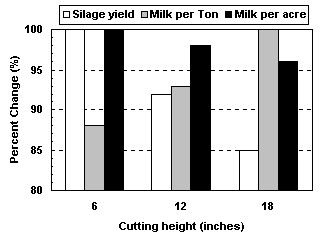December, 1998
Field Crops 28.47-20
Corn Silage Yield and Quality Trade-Offs When Changing Cutting Height
Joe Lauer, Corn Agronomist
Increasing the cutting height of corn silage decreases silage yield. But, what happens
to silage quality as the cutter bar is raised? Corn plant parts contain different
amounts of fiber and digestible energy. Raising the cutter bar on a silage chopper
will leave more of the lower corn stalk in the field, which is typically higher
in fiber and lower for digestible energy.
Most of the energy and value of corn silage is in kernels on the ear. Other plant
parts differ for fiber and digestible energy. Figure 1 shows the yield and quality
trade-off that exists for yield, milk per ton and milk per acre as the cutter bar
is raised. e for corn silage that is based on equations predicting intake and animal
requirements from data derived from National Research Council (NRC) tables on nutrient
requirements of dairy cattle (1978, 1989). Milk per ton approximates a balanced
ration meeting animal energy, protein, and fiber needs based on forage quality (in
vitro digestibility basis). Milk per ton is based on a standard cow weight
and level of milk production (1350 lb body weight and 90 lb/d at 3.8% fat). Both
milk per acre and milk per ton was calculated using a model derived from the spreadsheet
entitled, "MILK95," (Undersander et al., 1993). Milk per acre is
simply milk per ton multiplied by yield.
Corn silage yield decreased 15% as the cutter bar was raised from 6 to 18 inches
above the soil surface. Milk per ton was lowest when the cutter bar height was six
inches and greatest at a cutter bar height of 18 inches. Thus, even though silage
yield decreased 15% by raising the cutter bar 12 inches, silage quality (milk per
ton) increased. Milk per acre decreased 3-4%. Additionally, more beneficial crop
residue would be left in the field without sacrificing much milk per acre.

Literature Cited
Undersander, D.J., W.T. Howard, and R.D. Shaver. 1993. Milk per acre spreadsheet
for combining yield and quality into a single term. J. Prod. Agric. 6:231-235.
National Research Council, National Academy of Sciences. 1978. Nutrient requirements
of dairy cattle. 5th rev. ed. Washington, DC.
National Research Council, National Academy of Sciences. 1989. Nutrient requirements
of dairy cattle. 6th rev. ed. Washington, DC.